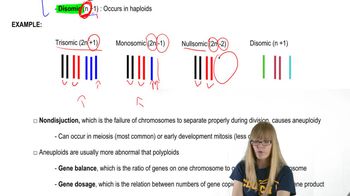How do we know how much genetic variation is in a population?
Table of contents
- 1. Introduction to Genetics51m
- 2. Mendel's Laws of Inheritance3h 37m
- 3. Extensions to Mendelian Inheritance2h 41m
- 4. Genetic Mapping and Linkage2h 28m
- 5. Genetics of Bacteria and Viruses1h 21m
- 6. Chromosomal Variation1h 48m
- 7. DNA and Chromosome Structure56m
- 8. DNA Replication1h 10m
- 9. Mitosis and Meiosis1h 34m
- 10. Transcription1h 0m
- 11. Translation58m
- 12. Gene Regulation in Prokaryotes1h 19m
- 13. Gene Regulation in Eukaryotes44m
- 14. Genetic Control of Development44m
- 15. Genomes and Genomics1h 50m
- 16. Transposable Elements47m
- 17. Mutation, Repair, and Recombination1h 6m
- 18. Molecular Genetic Tools19m
- 19. Cancer Genetics29m
- 20. Quantitative Genetics1h 26m
- 21. Population Genetics50m
- 22. Evolutionary Genetics29m
21. Population Genetics
Allelic Frequency Changes
Problem 4
Textbook Question
Describe how natural selection can produce balanced polymorphism of allele frequencies through selection that favors heterozygotes.
 Verified step by step guidance
Verified step by step guidance1
Understand the concept of balanced polymorphism, which occurs when two or more alleles are maintained in a population's gene pool at stable frequencies over time.
Recognize that heterozygote advantage (also called overdominance) is a form of natural selection where individuals with heterozygous genotypes have higher fitness than either homozygous genotype.
Set up the fitness values for the three genotypes: let the fitness of homozygote AA be , heterozygote Aa be , and homozygote aa be , with and .
Use the concept that selection will increase the frequency of the heterozygote-favored allele combinations, but because both alleles contribute to heterozygotes, neither allele is lost, leading to a stable equilibrium of allele frequencies.
Explain that the equilibrium frequencies can be calculated by setting the change in allele frequency to zero and solving the equations derived from the relative fitness values, showing how natural selection maintains both alleles in the population.
 Verified video answer for a similar problem:
Verified video answer for a similar problem:This video solution was recommended by our tutors as helpful for the problem above
Video duration:
2mPlay a video:
Was this helpful?
Key Concepts
Here are the essential concepts you must grasp in order to answer the question correctly.
Natural Selection
Natural selection is the process where individuals with traits better suited to their environment have higher survival and reproductive success. Over time, this leads to changes in allele frequencies within a population, favoring alleles that confer a fitness advantage.
Recommended video:
Guided course

Natural Selection
Balanced Polymorphism
Balanced polymorphism occurs when two or more alleles are maintained in a population at stable frequencies due to selective advantages. This genetic diversity persists because heterozygotes have higher fitness than either homozygote, preventing any single allele from becoming fixed or lost.
Recommended video:
Guided course

Aneuploidy
Heterozygote Advantage
Heterozygote advantage is a form of selection where individuals with two different alleles (heterozygotes) have greater fitness than those with two identical alleles (homozygotes). This advantage maintains multiple alleles in the gene pool, as seen in cases like sickle cell trait providing malaria resistance.
Recommended video:
Guided course

Hardy Weinberg
Related Videos
Related Practice
Textbook Question
368
views


